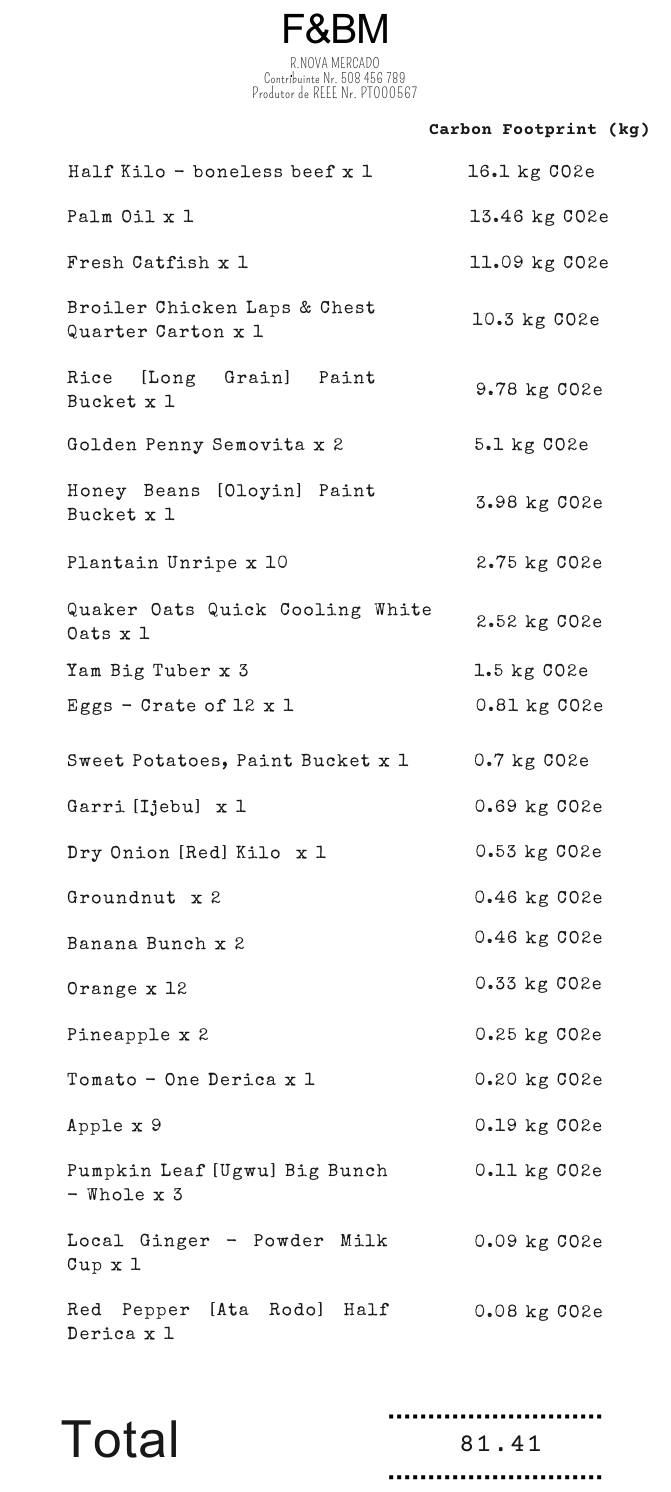Can Conscious Consumerism Make a Difference?

After attending the OPF Academy and the Terra.do Corporate Sustainability Accelerator, I became curious about the carbon footprint of a typical Nigerian family's grocery shopping. With environmental awareness on the rise, I thought it would be insightful to see how our everyday purchases add up.

Collecting the Data
I couldn't find specific data on Nigerian shopping habits, so I created a hypothetical list. I used GoLemon to compile common food items, like local swallows and tubers, that you'd typically find in a Nigerian market. It's fascinating to think that small, individual choices—like what we buy—can contribute to a healthier planet.
After all, saving the planet starts with small, individual actions, right?



To determine the prices for each item, I used GoLemon and then organized everything in an Excel spreadsheet. I tracked each product's quantity, weight or volume, and cost. Once I finished with the first category, I moved on to the next, continuing the process until the entire shopping list was built.

With all the items added, I calculated each product's emissions. This involved multiplying a credible emissions factor by activity or spend data. To do this, I needed two key components:
- Emission Factors
- Activity Data or Spend Data
What is an emission factor?
What are activity-based and spend-based data?
Spend-based and activity-based are two methods of calculating the carbon emissions of products and activities. The difference between them lies in the type of data utilised.
Getting Emission Factors
To get the emissions factors, I checked CarbonCloud and Climatiq databases, while for the activity (weight) and spend (cost)-based data, I got them from GoLemon.

I noted that the climate footprint was assessed from cradle to farm gate for the emission factors. This included all stages of the life cycle—from the production of agricultural inputs, through farming processes, machinery use, and on-farm processing like drying, up to the point where the product is ready for market at the farm gate. However, the calculated climate footprint did not account for aspects like transport from the farm to consumers or packaging.
Once I gathered all the necessary data, I applied the formula to calculate the emissions or carbon footprint for each product.

The activity-based method calculates emissions by multiplying the actual physical quantity of the product—in this case, the weight of the food item—by the corresponding emission factor, which shows the emissions produced per kilogram. This method gives a more direct estimate of the emissions from producing that specific quantity of food product.
For this blog, I'll focus on activity-based emissions, especially since food production alone is responsible for 26% of global greenhouse gas emissions.
Results

Unsurprisingly, beef has the largest carbon footprint, emitting 16 kilograms of CO2e. This is primarily due to the land-intensive nature of beef production, which involves significant deforestation to create grazing land and methane emissions from cattle. As cows graze, they produce a lot of methane, a greenhouse gas with a much higher warming potential than CO2.
Palm oil was high on the list, which was somewhat of a surprise to me as I expected animal-based food products to be in the top three on the list. On further reading, I found out that palm oil's environmental impact is due to deforestation and the drainage of peat soils, which release massive amounts of CO2 when converted for oil palm plantations.
Broiler chicken, while not as carbon-intensive as beef, still contributes a significant amount of emissions, primarily due to the feed it consumes. Rice, a staple in many Nigerian households, completes the top four. Rice farming involves flooded fields, which create methane emissions due to waterlogged soils. Methane, as previously mentioned, has a much higher warming potential than CO2, making rice an exception compared to other plant-based foods. This contributes to its relatively high carbon footprint.
At the bottom of the chart, we see plant-based foods like sweet potatoes, groundnuts, and oranges contributing significantly less to overall emissions. As other studies have shown, animal-based foods tend to have a much higher carbon footprint than plant-based options. Most plant-based foods, such as grains, vegetables, and fruits, have lower carbon footprints than animal-based products. However, some, like rice, can have higher emissions due to specific cultivation practices.

Comparisons
Now, let's compare the total emissions to the equivalent amount of carbon dioxide (CO2) emissions using that amount. The shopping list's total carbon footprint is 81.41 kg CO2e.
This is equivalent to the greenhouse gas emissions from an average gasoline-powered car driving 208 miles—about the distance from Lagos to Ado-Ekiti, Nigeria, London to Manchester in the UK, or New York City to Maryland in the US.

And the equivalent of CO2 emissions from 9.2 gallons of gasoline, and fully charging 5,375 smartphones


What is the solution?
Regular food purchases can contribute significantly to carbon emissions, though most of these emissions are beyond our control by the time we reach the market. The majority of emissions are tied to the production process itself, long before the products are transported to the market or shelves.

But this is not to say all hope is lost. You can take personal steps to reduce your carbon footprint, such as cutting down on foods with a high carbon footprint, which means giving up most animal-based products.
A case study that caught my attention was a project by Nicholas Sutherland. He demonstrated how adding carbon impact data to grocery item packaging can help lower demand-side carbon impact. By enabling consumers to purchase low-impact grocery items, we can drive conscious consumerism that positively influences the environment.
In the example, Nicholas shows three shoppers with different shopping behaviors and the corresponding impacts of their decisions on their carbon footprint (weekly, monthly, and annually).
- Shopper A: Average shopper, chooses all typical protein and dairy options regardless of GHG labeling.
- Shopper B: Climate conscious, avoids red meat, uses GHG labeling to compare items, and chooses some alternative proteins and dairy options.
- Shopper C: Plant-based diet, uses GHG labeling to minimize their footprint.
It's clear that Shopper C has the lowest footprint as they opt for a plant-based diet, followed by Shopper B, who avoids red meat (beef, mutton, pork, etc.), and Shopper A (the regular shopper) has the highest footprint due to their choices of typical protein and dairy options.
Grocery Item GhG Labeling by Nicholas Sutherland
While I’m not advocating for completely giving up on animal-based proteins (red meat, etc.), simply being more conscious of the environmental impact of our food choices can help us make more informed decisions, whether we're shopping or planning meals.
As Nicholas pointed out, climate-conscious behavior and its impacts don't have to be all or nothing. Even periodic avoidance of high-impact food products like beef is extremely beneficial to the environment, especially when considering consumer behavior at scale. Every small step adds up to a larger collective impact.
If you found this insightful or want to dive deeper into strategies for reducing your carbon footprint, feel free to reach out! You can connect with me on LinkedIn or email me directly at chris.alafaa@gmail.com.




